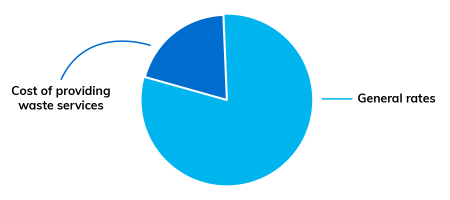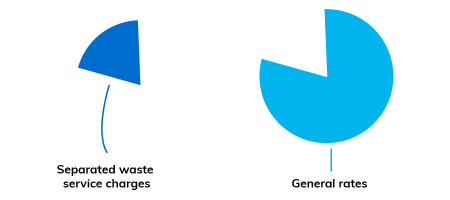For 2023/24 the rate in the dollar is 0.03223754.
How the rate in the dollar is calculated
Step 1: We determine the total funds needed to deliver services and infrastructure for the next financial year within the constraints of the rate cap.
Step 2: Divide that by the combined value of all rateable properties in Yarra.
This equals the rate in the dollar. We then apply the rate in the dollar to your property.
To calculate your rates for the year multiply the Net Annual Value of your property by the rate in the dollar: 0.03223754.
The Net Annual Value of your residential property is the Capital Improved Value of your property multiplied by 5% by state legislation. Commercial and industrial properties are rated similarly but include an additional component.
The Capital Improved Value of your property is the total market value of the land plus buildings and any other improvements.
Example for a $800,000 property
- Capital Improved Value = $800,000
- $800,000 x 5% = $40,000 (Net Annual Value)
- $40,000 x 0.03223754 (Rate in the Dollar) = a base rates bill of $1,289.5016
Waste services charges
In March 2023, Yarra City Council resolved to separate waste service charges from general rates to account for the increasing costs of waste and recycling services, in line with all other Victorian councils.
Yarra City Council is not introducing any new charges with this change. Previously a component of your general rates pays for waste services. By separating waste service charges from general rates we will be removing the cost of providing waste services to the community from general rates and listing it as a separate item on your annual rates notice.
Importantly, residents will only be charged for the cost of waste services once, through the separated waste service charges.
Our current model:

Separated waste service charges:

Yarra’s Waste Services Charge will be made up of two elements: a public waste rate and a kerbside waste rate. The term ‘rate’ in this instance means that the cost will be scaled based on property value. This is the same way we calculate general rates. The kerbside waste rate will only be applied to properties that receive a kerbside waste collection service from Yarra.
If you have any questions or concerns about how the Waste Services Charge has been applied to your property, please reach out to our Customer Experience team on 9205 5555 or by email [email protected].
Fire Services Property Levy
Your rates notice includes a separate Fire Services Property Levy, which we are obliged to collect on behalf of the State Government to fund the Metropolitan Fire Brigade and the Country Fire Authority (CFA).
Although this levy appears on rates notices, it is not a council charge for council services. It replaces the existing fire services levy charged by insurance companies in your home insurance premiums.
The Fire Services Property Levy comprises a fixed component of $125 for residential properties and $254 for non-residential properties, plus a variable component based on a percentage of the capital improved value (CIV) of the property.
The State Government also includes a variable component when calculating the Fire Services Property Levy.
For more information and how to calculate your levy, visit the State Revenue Office Victoria website.
A concession will be available to some Department of Veterans Affairs gold card holders and Pensioner Concession Card holders.
What is rate capping?
The State Government has capped rate increases at 3.5% for 2023/2024 and we have elected to apply this 3.5% increase rather than seek an exemption from the cap.
It is important to remember that the 3.5% cap does not apply to your individual bill but rather to the total amount of money that we are seeking from rates revenue. Most properties will experience rate increases that are slightly higher or lower than 3.5%.
The MAV has produced this short video explaining rate-capping in simple terms.
For 2023/24 the rate in the dollar is 0.03223754.
How the rate in the dollar is calculated
Step 1: We determine the total funds needed to deliver services and infrastructure for the next financial year within the constraints of the rate cap.
Step 2: Divide that by the combined value of all rateable properties in Yarra.
This equals the rate in the dollar. We then apply the rate in the dollar to your property.
To calculate your rates for the year multiply the Net Annual Value of your property by the rate in the dollar: 0.03223754.
The Net Annual Value of your residential property is the Capital Improved Value of your property multiplied by 5% by state legislation. Commercial and industrial properties are rated similarly but include an additional component.
The Capital Improved Value of your property is the total market value of the land plus buildings and any other improvements.
Example for a $800,000 property
- Capital Improved Value = $800,000
- $800,000 x 5% = $40,000 (Net Annual Value)
- $40,000 x 0.03223754 (Rate in the Dollar) = a base rates bill of $1,289.5016
Waste services charges
In March 2023, Yarra City Council resolved to separate waste service charges from general rates to account for the increasing costs of waste and recycling services, in line with all other Victorian councils.
Yarra City Council is not introducing any new charges with this change. Previously a component of your general rates pays for waste services. By separating waste service charges from general rates we will be removing the cost of providing waste services to the community from general rates and listing it as a separate item on your annual rates notice.
Importantly, residents will only be charged for the cost of waste services once, through the separated waste service charges.
Our current model:

Separated waste service charges:

Yarra’s Waste Services Charge will be made up of two elements: a public waste rate and a kerbside waste rate. The term ‘rate’ in this instance means that the cost will be scaled based on property value. This is the same way we calculate general rates. The kerbside waste rate will only be applied to properties that receive a kerbside waste collection service from Yarra.
If you have any questions or concerns about how the Waste Services Charge has been applied to your property, please reach out to our Customer Experience team on 9205 5555 or by email [email protected].
Fire Services Property Levy
Your rates notice includes a separate Fire Services Property Levy, which we are obliged to collect on behalf of the State Government to fund the Metropolitan Fire Brigade and the Country Fire Authority (CFA).
Although this levy appears on rates notices, it is not a council charge for council services. It replaces the existing fire services levy charged by insurance companies in your home insurance premiums.
The Fire Services Property Levy comprises a fixed component of $125 for residential properties and $254 for non-residential properties, plus a variable component based on a percentage of the capital improved value (CIV) of the property.
The State Government also includes a variable component when calculating the Fire Services Property Levy.
For more information and how to calculate your levy, visit the State Revenue Office Victoria website.
A concession will be available to some Department of Veterans Affairs gold card holders and Pensioner Concession Card holders.
What is rate capping?
The State Government has capped rate increases at 3.5% for 2023/2024 and we have elected to apply this 3.5% increase rather than seek an exemption from the cap.
It is important to remember that the 3.5% cap does not apply to your individual bill but rather to the total amount of money that we are seeking from rates revenue. Most properties will experience rate increases that are slightly higher or lower than 3.5%.
The MAV has produced this short video explaining rate-capping in simple terms.


